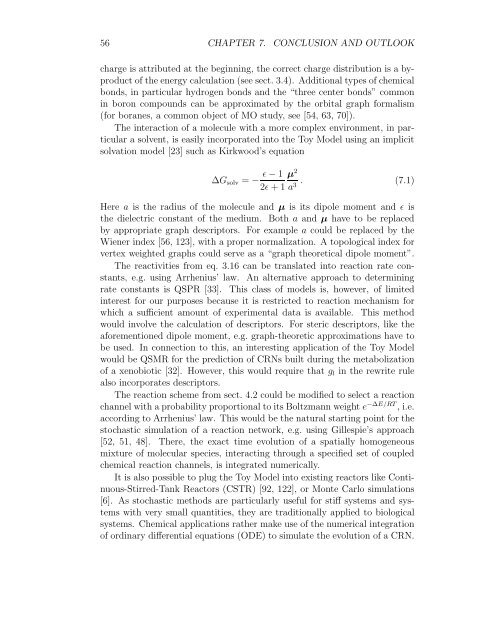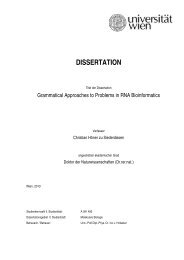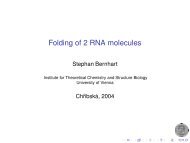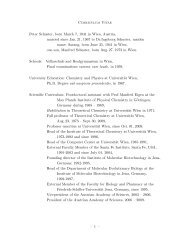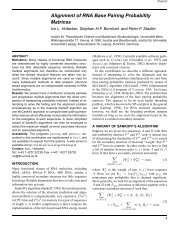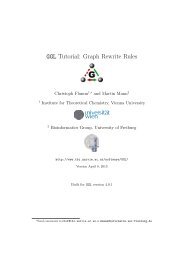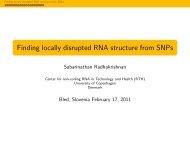A Toy Model of Chemical Reaction Networks - TBI - Universität Wien
A Toy Model of Chemical Reaction Networks - TBI - Universität Wien
A Toy Model of Chemical Reaction Networks - TBI - Universität Wien
You also want an ePaper? Increase the reach of your titles
YUMPU automatically turns print PDFs into web optimized ePapers that Google loves.
56 CHAPTER 7. CONCLUSION AND OUTLOOK<br />
charge is attributed at the beginning, the correct charge distribution is a byproduct<br />
<strong>of</strong> the energy calculation (see sect. 3.4). Additional types <strong>of</strong> chemical<br />
bonds, in particular hydrogen bonds and the “three center bonds” common<br />
in boron compounds can be approximated by the orbital graph formalism<br />
(for boranes, a common object <strong>of</strong> MO study, see [54, 63, 70]).<br />
The interaction <strong>of</strong> a molecule with a more complex environment, in particular<br />
a solvent, is easily incorporated into the <strong>Toy</strong> <strong>Model</strong> using an implicit<br />
solvation model [23] such as Kirkwood’s equation<br />
∆G solv = − ɛ − 1 µ 2<br />
2ɛ + 1 a . (7.1)<br />
3<br />
Here a is the radius <strong>of</strong> the molecule and µ is its dipole moment and ɛ is<br />
the dielectric constant <strong>of</strong> the medium. Both a and µ have to be replaced<br />
by appropriate graph descriptors. For example a could be replaced by the<br />
<strong>Wien</strong>er index [56, 123], with a proper normalization. A topological index for<br />
vertex weighted graphs could serve as a “graph theoretical dipole moment”.<br />
The reactivities from eq. 3.16 can be translated into reaction rate constants,<br />
e.g. using Arrhenius’ law. An alternative approach to determining<br />
rate constants is QSPR [33]. This class <strong>of</strong> models is, however, <strong>of</strong> limited<br />
interest for our purposes because it is restricted to reaction mechanism for<br />
which a sufficient amount <strong>of</strong> experimental data is available. This method<br />
would involve the calculation <strong>of</strong> descriptors. For steric descriptors, like the<br />
aforementioned dipole moment, e.g. graph-theoretic approximations have to<br />
be used. In connection to this, an interesting application <strong>of</strong> the <strong>Toy</strong> <strong>Model</strong><br />
would be QSMR for the prediction <strong>of</strong> CRNs built during the metabolization<br />
<strong>of</strong> a xenobiotic [32]. However, this would require that g l in the rewrite rule<br />
also incorporates descriptors.<br />
The reaction scheme from sect. 4.2 could be modified to select a reaction<br />
channel with a probability proportional to its Boltzmann weight e −∆E/RT , i.e.<br />
according to Arrhenius’ law. This would be the natural starting point for the<br />
stochastic simulation <strong>of</strong> a reaction network, e.g. using Gillespie’s approach<br />
[52, 51, 48]. There, the exact time evolution <strong>of</strong> a spatially homogeneous<br />
mixture <strong>of</strong> molecular species, interacting through a specified set <strong>of</strong> coupled<br />
chemical reaction channels, is integrated numerically.<br />
It is also possible to plug the <strong>Toy</strong> <strong>Model</strong> into existing reactors like Continuous-Stirred-Tank<br />
Reactors (CSTR) [92, 122], or Monte Carlo simulations<br />
[6]. As stochastic methods are particularly useful for stiff systems and systems<br />
with very small quantities, they are traditionally applied to biological<br />
systems. <strong>Chemical</strong> applications rather make use <strong>of</strong> the numerical integration<br />
<strong>of</strong> ordinary differential equations (ODE) to simulate the evolution <strong>of</strong> a CRN.


